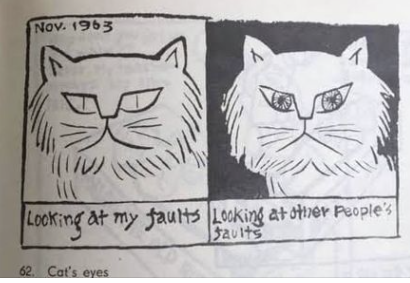
The image portrays a two-panel comic strip, a fine example of mid-century Chinese satirical cartoons, reminiscent of the works of the renowned cartoonist Hua Junwu. While the comic is not attributed to Hua Junwu directly, it carries the essence of his style, using humor and exaggeration to critique social behaviors.
The strip, dated November 1963, is titled “Cat’s eyes,” a clever nod to the idiom “cat’s-eye view,” but also a literal representation of the subject matter. Each panel shows the face of a cat, but with differing eye expressions, used metaphorically to comment on the human propensity for self-reflection versus the scrutiny of others.
In the first panel, “Looking at my faults,” the cat’s eyes are depicted as narrow slits. This artistic choice is laden with meaning, suggesting the all-too-human tendency to be myopic about one’s own imperfections. The nearly closed eyes of the cat humorously imply a willful ignorance or a subdued acknowledgment of personal shortcomings.
The second panel stands in stark contrast, with the label “Looking at other people’s faults” and the cat’s eyes wide open. This exaggerated alertness embodies the critical gaze that individuals often direct at others. The open eyes serve as a visual metaphor for the detailed scrutiny and sometimes unforgiving judgment that people readily apply to the flaws of their peers.
The simplicity of the comic—using only the cat’s face and the accompanying text—mirrors the clear yet powerful style typical of Hua Junwu, who was known for his ability to distill complex ideas into single images. The humor emerges not just from the visual gag but from the insightful reflection on human nature, a characteristic approach of mid-century Chinese satirical cartoons.
This piece encapsulates the human dichotomy of self-perception versus the perception of others in a manner that is as humorous as it is thought-provoking. It invites the reader to ponder on the irony of this aspect of human behavior, just as Hua Junwu’s work often did, making a bold statement on societal norms through the deceptively simple medium of cartoon art. The enduring relevance of this theme highlights the universality and timelessness of such satirical works, which continue to resonate with audiences by shedding light on the quirks of the human condition.

